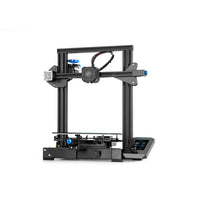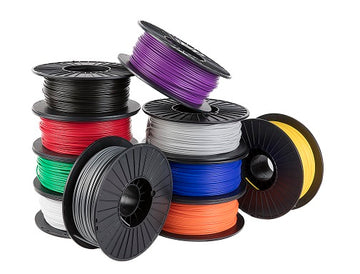The Benefits of Dual Extrusion 3D Printing
Having a dual extruder integrated with your 3D Printer opens up a tremendous amount of possibilities for your printing ventures. We at Print Your Mind have investigated different uses and prepared you a starter’s guide to dual extrusion printing.
Water-Dissolvable PVA Supports
While single extruder 3D prints leave traces of support material in most cases, with a dual extruder this is a thing of the past. Polyvinyl alcohol (PVA) is a specific filament that when installed on the second extruder, acts as a support material. It is water soluble meaning that it is not a breakaway support but fully disintegrates from the 3D print when left in water for 24 hours. By heating the water to 60 degrees Celsius and stirring it can be dissolved within 30 minutes. What remains is a very clean print without distortions and flawed overhangs. If we turn it around and use PLA as a breakaway support for PVA, this allows us to create dissolvable sacrificial molds to use like lost wax casts.

Figure 4. Models employing water dissolvable PVA support structures [11].
Printing with PVA supports allows you to print any geometry which opens up new applications:
Archeological and Medical. Models with complex cavities such as skulls and organs
Hollow Volumes. One escape hole will dissolve all internal structures, for example in musical instruments, bottles and electronics enclosures
Complex Wireframes. Models where support material would otherwise be inaccessible or damage delicate parts with breakaway e.g. trabecular, voronoi, molecular and architectural models
Microfluidics [12]
Mechanical. Assemblies with moving parts can now be created in a single print. Nylon combines well with PVA for models with superior strength.
Data Visualization. Complex models with high detail requirements and multiple layers, e.g. aerodynamics, geographic erosion models where water will gradually erode the PVA away revealing underlying formations, visualizing stress gradients.
Sculpture. No marks left on overhanging and hollow areas.
Because PVA is chemically similar to Polypropylene, a household plastic, its environmental safety is widely debated. However several studies have found it to be safe and it is listed as food safe as well by the FDA. Therefore it is used as a glazing agent, thickener and as foil for medical and dishwasher tablets. It is only toxic in fairly large doses and fully biodegradable [3,4]. PVA is a bit moisture-sensitive so we advise to store it in a closed and dry container, also see our post How to Properly Store your 3D Printer Filaments.
Dual-Color 3D Printing
Any cartoon artist, graphic or product designer can tell you the value of having two versus one color to work with. The same goes for 3D printing. For character designs, there is now no need to paint your models except for the small details. It allows product designers to have their prototypes make the difference in visual impact through functional details and graphics. When combining a transparent and opaque material, it opens up new possibilities for products like lampshades, vases [1], storage containers, toys and user interfaces.

Figure 3. Dual-color 3D prints.
In education, a dual-color print makes an object much more communicative. Think mechanical models for example to explain ball bearings, geometry models with information written on the sides in a distinct color, anatomical models and complex scientific models such as molecules [6], fluid flows and aerodynamic models. Going a step further it is possible to 3D print color gradients for artwork or analytic visualization models using halftoning techniques [2].
Dual-Material 3D Printing
A dual extruder allows you to blend materials with different mechanical properties such as flexibility. Whether or not a bond will form between two printed materials depends on its chemical composition. Figure 1 is a reference for the possible bonding combinations of our filaments. Dual-material 3D Printing opens up myriads of possibilities:
Integrated Hinges
Integrated Grip areas, Gaskets, Seals and Bumpers
Wearable items. Print flexible parts with integrated details, patterns and fasteners.
Free Interlocking parts. Combining materials that do not bond well, such as polypropylene (PP) and polycarbonate (PC), can be used to create interlocking parts with very little clearance. One material will act as the support for the other material and later they will easily break away from each other.
Saving on exclusive materials. Print materials such as Woodfill only on the outer shell layer, with regular PLA for the rest of the piece.
Functional areas. Combine a stiff material such as polycarbonate with a more pliable one such as T-Glase PETT or PLA to embed areas e.g. for tapping threads or attaching inserts.

Figure 1. Bond Compatibility of Dual Extrusion Filaments [9].

Figure 2. Left: Drill with integrated grip areas [10]. Right: Flexible material for grip combined with a semi-flexible material for structure.
So far we have shown you a few of the many reasons to invest in a dual extruder system. The Ultimaker 3, available in the Print Your Mind 3D store, has unprecedented dual extruder technology with interchangeable print head cores and an advanced extruder switching system that prevents unwanted oozing. For an even more advanced 3D printer, the new Ultimaker S5 has a larger build volume and capability for printing with composite materials. We also recommend the Lulzbot TAZ 6 equipped with additional Dual Extruder Tool Head that is excellent for multicolor printing and flexible materials.
References
1. Graziano, A., Paradiso, S., Palma, M. and Demasi, B. (2018) A.A.R.M. DigifabTURINg. Available from http://www.co-de-it.com/wordpress/digifabturing Last accessed May 21st 2018.
2. Jani, M. (2017) 3D hatching: Grayscale printing on the Ultimaker 3. https://ultimaker.com/en/blog/49783- 3d-hatching-grayscale-printing-on-the-ultimaker-3 Last accessed May 21st, 2018.
3. Pajak, J. Et al. (2010). Poly(vinyl alcohol) – biodegradable vinyl material. CHEMIK 2010, 64, 7-8, 523-530.
4. Polyvinyl Alcohol, PubChem. https://pubchem.ncbi.nlm.nih.gov/compound/Ethenol
5. Printyourmind3D (2017). How to Properly Store your 3D Printer Filaments. https://www.printyourmind3d.ca/blogs/articles/how-to-properly-store-your-3d-printing-filaments Last Accessed June 8th, 2018.
6. Thing 1809393. Chemteacher628 (2016). Solubility of Glucose Model. https://www.thingiverse.com/thing:1809393 Last Accessed June 8th, 2018.
7. Thing 2861994. Cipis (2018). Nefertiti Multimaterial Remix. https://www.thingiverse.com/thing:2862994 Last Accessed May 18th, 2018.
8. Thing 948045. R3ND3R (2015). Fashion Traffic Cones Collection. https://www.thingiverse.com/thing:948045 Last Accessed June 8th, 2018.
9. Ultimaker Material Compatibility. https://ultimaker.com/en/resources/49799-material-compatibility Last Accessed June 7th, 2018.
10. Ultimaker (2016). Hand Drill by Luis Cordoba. https://www.youtube.com/watch?v=Xw_lSQ3LVDc Last Accessed June 8th, 2018.
11. Ultimaker PVA. https://ultimaker.com/en/products/materials/pva Last Accessed May 21, 2018. 12. Vries, C. de (2017). Accessible 3D Printed Microfluidics Devices. https://ultimaker.com/en/stories/39228- cardiff-university-accessible-3d-printed-microfluidic-devices Last Accessed June 8th, 2018.






